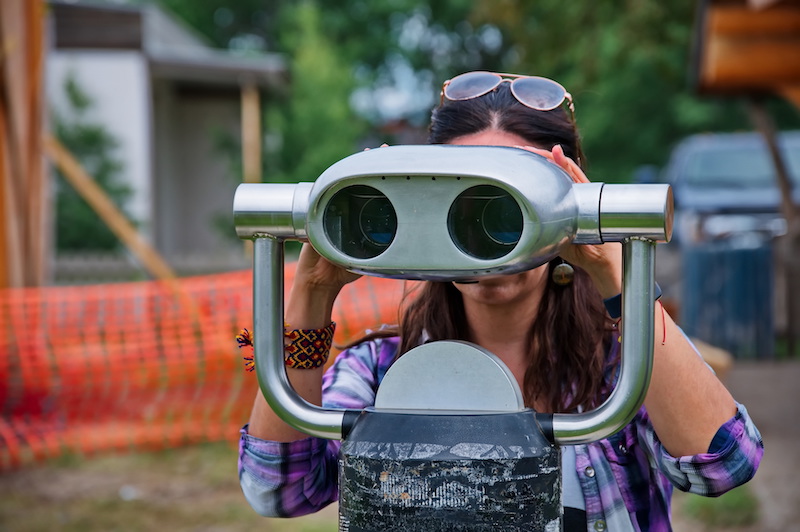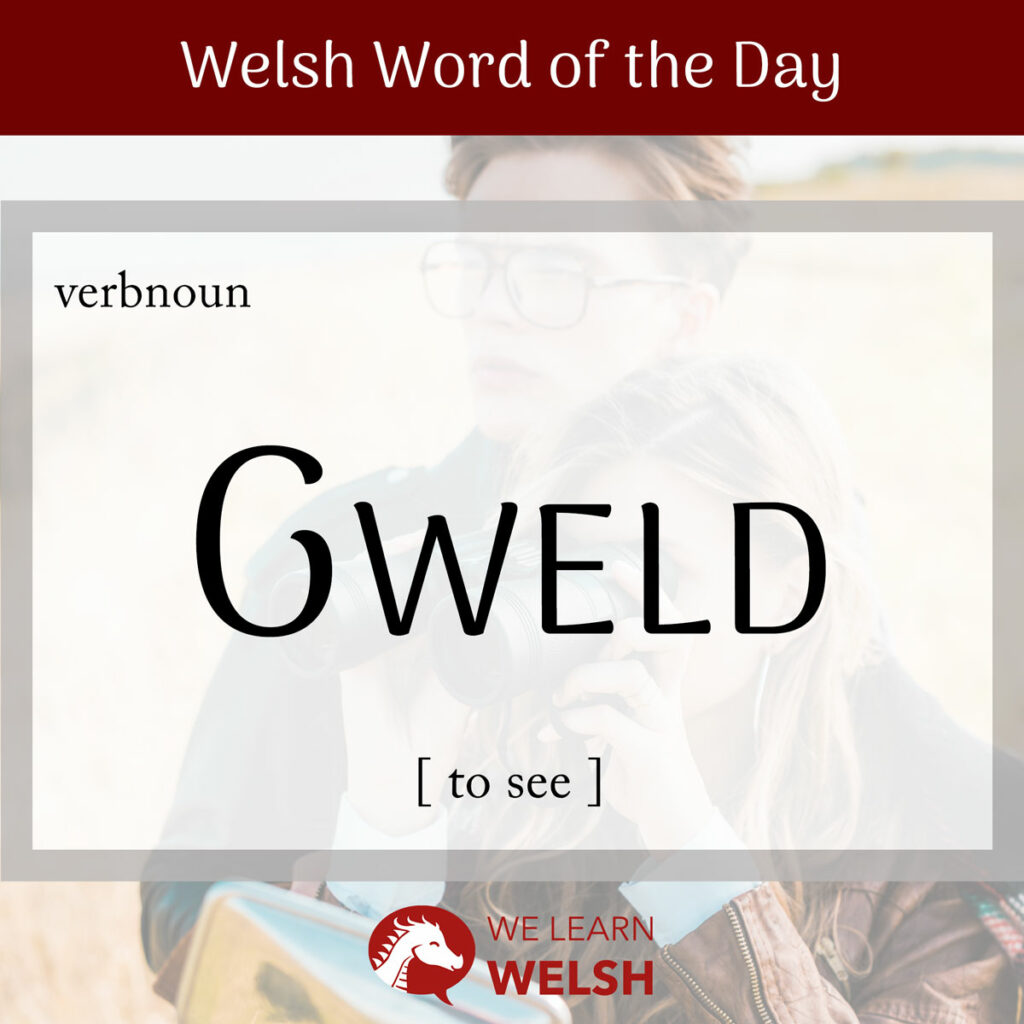When I was a child, I couldn’t understand the difference between edrych (looking) and gweld (seeing), in either Welsh or English. Though I’d say I have a handle on it now, I still wonder if there are any languages where the same word is used for both. Let me know if you know of any!
gweld
to see
Gweld comes from the older form gweled, which is still seen a lot in older poetry and archaic texts. Gweled itself is from the proto-Celtic root *weleti, a cognate of the Latin *voltus (facial expression).
Although this older form isn’t used at all in everyday speech or writing (even in the most formal of contexts), it survives in a way in words like gweledig (visible) and rhithweled (to hallucinate). Some people pronounce gweld slightly more like gweled, too.
Let’s quickly look at the mutations of gweld.
Soft mutation
weld
Nasal mutation
ngweld
Aspirate mutation
N/A
Gweld is a transitive verbnoun meaning to see. Overall, it’s used in similar ways to its English equivalent. It can mean to see as in to have the power of sight, to see as in to use one’s power of sight, to see as in to examine, to see as in to inquire, to see as in to see in the mind’s eye, to see as in to visit, to see as in to understand, and to see that as in to make sure.
There are also a few meanings that require a particular prefix, like the following:
- ymweld = to visit (though you can often also use gweld)
- rhagweld = to foresee
- cydweld = to agree
- anghydweld = to disagree
- cyfweld = to interview
One way that it’s used which is very different to English, though, is gweld eisiau (literally: to see wanting). This is a very, very common phrase meaning to miss or to want. It’s a good one to slip into conversations if you want your Welsh speech to sound more natural. Gweld colled (to see missing) is a synonym but in my experience it’s a lot rarer.
Rwy’n gweld dy eisiau di.
I miss you.
As I mentioned, to look or looking is edrych. Sometimes in South Wales you will hear disgwyl (to expect) used as a synonym of edrych, and Southerners often pronounce disgwyl as dishgwyl. Sbio (to spy) is also a very common synonym in colloquial speech, and often gives a sense of to have a look at something.
The noun version of edrych (as in to have a look at something) is golwg, which also means sight as in one’s sense of sight. It’s related to golygu (to view, to oversee, or to mean/signify).
These are the main conjugations of gweld that come up in everyday speech:
| Future | Conditional | Past | |
| First person singular | Gwela(f) i I will see | Gwelwn i I would see | Gwelais i I saw |
| First person plural | Gwelwn ni We will see | Gwelen ni We would see | Gwelon ni We saw |
| Second person singular / informal | Gweli di You will see | Gwelet ti You would see | Gwelaist ti You saw |
| Second person plural / formal | Gwelwch chi You will see | Gwelech chi You would see | Gweloch chi You saw |
| Third person singular | Gwelith o/e/hi He/she will see | Gwelai fo/fe/hi He/she would see | Gwelodd o/e/hi He/she saw |
| Third person plural | Gwelan nhw They will see | Gwelen nhw They would see | Gwelon nhw They saw |
For any other tenses, in everyday speech, we use periphrastic conjugations. This means you leave gweld in its root form, and use other conjugated verbs to express the tense of the sentence – like saying I am seeing instead of I see.
You can also use periphrastic conjugations instead of the conjugations in the table above (e.g. Bydda i’n gweld instead of Gwela i), so don’t worry if you’re finding it hard to remember them.

Gwelediad is one of our five main synhwyrau (senses) that we can use to canfod (perceive – but only in terms of sight) the world around us. The organ that we use to gweld is our llygaid (eyes, singular: llygad), although some of us (like me) need to wear sbectol (glasses) to assist the process!
Mi wela i di’n fuan!
I’ll see you soon!
Sbectol are prescribed by an optegydd (optician), though some people choose to wear lensys cyffwrdd (contact lenses) instead. Others don’t need them as they are able to gweld fel cath (see very well, lit: see like a cat), perhaps if they’ve been eating lots of moron (carrots).
Someone who does not have any golwg (eyesight) at all is dall (blind), a word that appears in multiple Celtic languages. It’s also possible to be lliwddall (colour-blind), which, interestingly, is far more common in men than in women.
Now, one of the first phrases you’re likely to come across as a learner of Welsh is os gwelwch yn dda. This literally means if you see well and it’s used to mean please. Let’s break it down:
- os = if
- gwelwch = the present/future tense second-person conjugation of gweld (to see)
- yn dda = well, the adverbial form of da (good)
What we’re missing above is chi (you, for formal contexts or when you’re speaking to multiple people). Technically, the full phrase would be os gwelwch chi’n dda, but the chi can be dropped here and usually is, because the conjugation indicates who you’re talking to and that you’re being respectful.
Dewch i fy ngweld, os gwelwch yn dda.
Come and see me, please (formal).
As gwelwch chi is for formal contexts, or multiple people, there is technically another version of this phrase for people you know well – os gweli di’n dda.
In this case, although it would be grammatically just as valid to drop the di as it is to drop the chi above, it’s never really done. And to be honest, you don’t hear this phrase that often anyway because if you know someone well enough to use ti/di instead of chi with them, you might be more likely to just go with the much simpler plîs. No prizes for guessing where that one comes from!
Dere i’m gweld, plîs.
Come and see me, please (informal).
In very informal expressions like the above, speakers also tend to be fairly casual about which mutation they would use. Therefore, you might here dere i’m gweld, dere i’m ngweld, and dere i’m weld depending on the region of the country you’re in.
Hyd y gwelaf i (as far as I see), we’ve covered the most important gweld terms and phrases. However, as with any Welsh word, usage varies throughout the country, and weird and wonderful expressions abound. If you use gweld in a way I’ve not mentioned, do leave a comment below os gwelwch yn dda 😉

